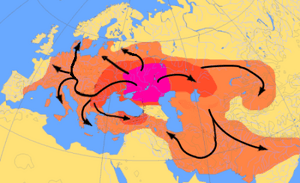Proto-Indo-Europeans facts for kids
The Proto-Indo-Europeans were a group of ancient people who lived a very long time ago, after the last Ice Age. We know about them mainly from their language, called Proto-Indo-European language (PIE). This language was never written down, but experts have pieced parts of it together. These people are important because many languages spoken today, like English, Spanish, Hindi, and Russian, come from their language.
Who Were the Ancient Indo-Europeans?
We learn about the Proto-Indo-Europeans not just from their language. We also get clues from archaeology (studying old objects) and archaeogenetics (studying ancient DNA). They were a group of related peoples who were the ancestors of many groups in the Bronze Age.
These people likely lived during the Copper Age, which was roughly from 5000 to 3000 BC. Most experts believe they lived in the steppes. These are large grasslands in Eastern Europe and Central Asia. Some researchers think they lived even earlier than that.
By the middle of the 2nd millennium BC (around 1500 BC), groups related to the Proto-Indo-Europeans had spread far. They reached places like Anatolia (modern Turkey), the Aegean Sea (near Greece), and Northern India. They also likely reached Western Europe.
Their Way of Life
The Proto-Indo-European culture had several interesting features:
- They were good at animal husbandry, which means raising animals. They had domesticated cattle, horses, and dogs.
- They practiced agriculture, growing crops like cereals. They used farming tools common for early farming communities.
- They lived in a climate that had winter snow.
- They used boats or rafts for travel across water.
- They had solid wheels, which they used for carts. However, they didn't yet have chariots with spoked wheels.
- They worshipped a sky god, whom they called *dyeus ph₂tēr. This means 'sky father'. You can see this in names like the Greek Zeus and the Roman Jupiter.
- They told long stories or sang songs. These often used special phrases, like 'imperishable fame'.
- Their society was patrilineal. This means family lines and property were passed down through the father's side.
The Proto-Indo-Europeans were a patrilineal society. They were probably half-nomadic, meaning they moved around with their animals. They relied on raising animals, especially cattle and sheep. They were among the first to domesticate the horse.
The cow was very important to them. It played a big role in their religion and stories, as well as in their daily lives. A man's wealth was likely measured by how many animals he owned, especially small livestock.
They had a polytheistic religion, meaning they worshipped many gods. Their religion involved sacrifices, probably led by priests. They buried their dead in large mounds called barrows or in tomb chambers. Important leaders might have been buried with their belongings. Sometimes, members of their households or wives were also buried with them.
Many Indo-European societies had a three-part division of people:
- Priests: Those who led religious ceremonies.
- Warriors: A class of fighters.
- Peasants or farmers: Those who worked the land.
If there was a separate warrior class, it might have been made up of young, unmarried men. They followed a special warrior code. Some stories suggest these warriors felt a connection to wolves or dogs.
In terms of technology, they lived in the early Bronze Age. They used tools and weapons made of bronze. They also knew about silver and gold. They raised sheep for their wool and made textiles by weaving. They knew about the wheel, using it for carts pulled by oxen. Later Proto-Indo-European groups might have used horse-drawn chariots in battles.
We don't know for sure what these people called themselves. The word Aryo- (which some think means "those who plow") was used by some groups later on. However, the Proto-Indo-Europeans themselves did not have writing. So, we cannot be certain if Aryo- was their own name for themselves.
Related Topics
- Proto-Indo-European language
- Comparative linguistics
- List of Indo-European roots
- Urheimat
- Armenian hypothesis
- Archaeogenetics
- Kurgan
- Aryan
More Information
 In Spanish: Pueblo protoindoeuropeo para niños
In Spanish: Pueblo protoindoeuropeo para niños


